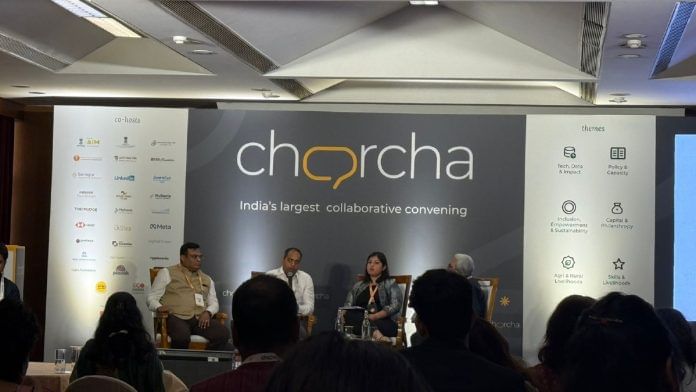New Delhi: India’s race to become an AI powerhouse will require more than a booming supply of tech talent; it demands a fundamental rethink of how India builds trust, skills, and local ecosystems around emerging AI tech. This was the central message from a panel at Charcha 2025, titled, “Beyond Supply: Has India’s Human Capital Equation for AI Gone Askew?”
Charcha is an annual gathering of India’s social impact sector that brings together sarkar (government leaders), samaaj (civil society groups) and bazaar (private sector) to “chart India’s roadmap to Viksit Bharat”.
The session was an official pre-summit event for the upcoming India AI Summit 2026 attended by Amitabh Nag, CEO of Digital India Bhashini Division (MeitY); Madhukar Yarra, CEO of NextWealth; and Dr Aditi Surie, Assistant Professor at Indian Institute for Human Settlements.
The session was moderated by Sujith John, Deputy Resident Editor at the Times of India.
While global corporations setting up GCCs (global capability centers) in India continue to express confidence in the availability of skilled AI engineers, the panel argued that India’s real challenge lies elsewhere.
“The question is no longer about supply-side skilling,” said Sujith. “The question is whether we are creating enough demand for jobs that can generate mass employment for India’s youth.”
Yarra, whose company employs more than 5,000 people across India’s small towns, explained that AI-enabled jobs are evolving beyond data annotation. As AI systems scale in real-world settings, an entirely new class of work, “inference-related tasks”, is emerging.
“AI is probabilistic, not deterministic,” Yarra said. “Every AI system requires humans in the loop for review, validation and intervention. That creates large volumes of specialised but scalable jobs. This is where India has a massive opportunity.” He cited the example of remote operators who support self-driving cars in the US, stepping in when the AI falters. In India, he noted, similar human oversight jobs already exist, like the digital KYC, online fraud detection and other AI-assisted workflows.
Nag, who is leading the National Language Translation Mission (NLTM), a key initiative to eliminate language barriers in India, described how the central government’s mission has already created a large value chain of AI work involving data collection, speech and text annotation, model training, validation and adaptation, much of it multilingual.
“India has less than 5 percent of the world’s digital data,” Nag said. “We had to build this from the ground up, collecting speech data from villages, creating parallel collections of written or spoken texts, validating datasets, building glossaries for domain adaptation. Each layer created thousands of new micro-jobs,” he added.
He also said that the next wave will involve not just using AI systems but continuously improving them. “AI systems are not finished products. They need constant feedback. Taking these models into rural areas for validation will create a massive volume of new work.”
Dr Surie highlighted that while AI supply chains offer a spectrum of jobs, workers face serious challenges around trust, job discovery, digital literacy and protection from scams. “India has a young, educated population ready for this work,” she said. “But many workers, especially women, struggle to even find legitimate opportunities. We need formal systems to recognise their skills and give them digitally verifiable credentials they can carry across jobs.”
She argued that India’s labour statistics, skill identification systems and institutional frameworks must evolve to recognise home-based AI workers, many of whom are women balancing care responsibilities.
While each panelist had different concerns and insights regarding the jobs generated by the AI, they all agreed that the future of India’s AI workforce lies outside metros. Reliable internet, growing digital familiarity, and the rise of local entrepreneurs have already made smaller towns fertile ground for AI-enabled services. “Local entrepreneurship, not just big IT companies, will drive the next wave of distributed AI work,” Yarra said.
ThePrint is a media partner for charcha, organised by the*spark forum.
(Edited by Amrtansh Arora)
Also Read: Charcha 2025 is building India’s next infrastructure: the capacity to work together






